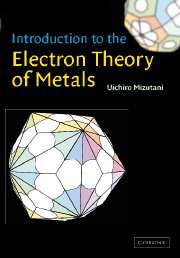Book contents
- Frontmatter
- Contents
- Preface
- 1 Introduction
- 2 Bonding styles and the free-electron model
- 3 Electrons in a metal at finite temperatures
- 4 Periodic lattice, and lattice vibrations in crystals
- 5 Conduction electrons in a periodic potential
- 6 Electronic structure of representative elements
- 7 Experimental techniques and principles of electronic structure-related phenomena
- 8 Electronic structure calculations
- 9 Electronic structure of alloys
- 10 Electron transport properties in periodic systems (I)
- 11 Electron transport properties in periodic systems (II)
- 12 Superconductivity
- 13 Magnetism, electronic structure and electron transport properties in magnetic metals
- 14 Electronic structure of strongly correlated electron systems
- 15 Electronic structure and electron transport properties of liquid metals, amorphous metals and quasicrystals
- Appendix 1 Values of selected physical constants
- Principal symbols (by chapter)
- Hints and answers
- References
- Materials index
- Subject index
10 - Electron transport properties in periodic systems (I)
Published online by Cambridge University Press: 20 November 2009
- Frontmatter
- Contents
- Preface
- 1 Introduction
- 2 Bonding styles and the free-electron model
- 3 Electrons in a metal at finite temperatures
- 4 Periodic lattice, and lattice vibrations in crystals
- 5 Conduction electrons in a periodic potential
- 6 Electronic structure of representative elements
- 7 Experimental techniques and principles of electronic structure-related phenomena
- 8 Electronic structure calculations
- 9 Electronic structure of alloys
- 10 Electron transport properties in periodic systems (I)
- 11 Electron transport properties in periodic systems (II)
- 12 Superconductivity
- 13 Magnetism, electronic structure and electron transport properties in magnetic metals
- 14 Electronic structure of strongly correlated electron systems
- 15 Electronic structure and electron transport properties of liquid metals, amorphous metals and quasicrystals
- Appendix 1 Values of selected physical constants
- Principal symbols (by chapter)
- Hints and answers
- References
- Materials index
- Subject index
Summary
Prologue
Electron transport properties can be investigated by measuring the response of conduction electrons to a temperature gradient or to external fields such as an electric field, a magnetic field, or a combination of these applied to a specimen. In this chapter, we study basic transport properties with subsequent derivation of the Boltzmann transport equation. The electrical conductivity is then formulated in the light of the Boltzmann transport equation. The temperature-dependent electrical resistivity expression known as the Baym resistivity formula is derived by taking into account the electron–phonon interaction and is applied to obtain the well-known Bloch–Grüneisen law for a crystal metal. The remaining transport properties including the thermal conductivity, the thermoelectric power, the Hall effect and the magnetoresistance will be discussed in Chapter 11.
The Drude theory for electrical conductivity
In Chapter 2, we learned that electrons on the Fermi surface in a metal like Na carry a Fermi wave number kF of the order of a few 10 nm-1, which is converted to a Fermi velocity vF of approximately 106 m/s through the relation vF=ħkF/m. In spite of such high velocities of electrons on the Fermi surface, no electrical current can flow, unless an electric field is applied. The reason for this is that the Fermi surface is always symmetric with respect to the origin in reciprocal space and that there always exists an electron with -vF for the electron with vF. Obviously, a current flows only when the applied field displaces the Fermi sphere from the origin and its symmetrical geometry breaks.
- Type
- Chapter
- Information
- Introduction to the Electron Theory of Metals , pp. 249 - 292Publisher: Cambridge University PressPrint publication year: 2001
- 1
- Cited by

